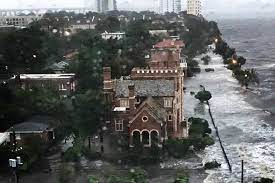By John Burr, Resilient Jax
Now it is set in concrete: Downtown Jacksonville faces a dire flooding threat from sea-level rise and storm surges.
The 12-story FIS corporate headquarters being built on the north bank of the St. Johns River offers a crucial lesson for the future of downtown.
The 377,000-square foot office building will be built to stay dry in floodwaters up to seven feet higher than what federal guidelines call for, according to the engineering consultant that advised the design team.
“The FIS building is a poster child of how to do it right,” Erik Olsen, principal engineer emeritus of Olsen Associates, Inc., said in a recent presentation to the Jacksonville chapter of the American Institute of Architects. (see video).
While FIS understands the threat posed by sea-level rise, Jacksonville city officials do not, Olsen said.

He said city officials are “five to six years behind the curve” compared with counties in South Florida and on the state’s west coast in terms of preparing for flooding from sea-level rise and storm surges.
“It’s being slow-walked, in my opinion,” he said of Jacksonville’s approach to resiliency, which is the term used to describe the steps needed for cities to be able to defend themselves against the dangers of climate change, particularly sea-level rise.
“The fact of life is the big players (developers) know what resiliency is all about,” Olsen told the architecture trade group. But city officials are not keeping up.
“The word needs to get out as to the facts of life with respect to various sea-level rise scenarios,” Olsen said.
An earlier city study group evaluated a forecast of two feet of water rise in downtown Jacksonville by 2060, 39 years from now.
Given that projection, 2018 federal flood maps, which Olsen said the city relies on to quantify flood risk, are already outdated and “woefully inadequate.”
Using the FIS building as an example, Olsen explained that water levels in the river during 2017’s Tropical Storm Irma were roughly three feet higher than federal flood predictions for a 100-year storm, or a storm that could be expected to hit once a century.

Add the two additional feet forecast from sea-level rise, and another two to three feet of wave action expected during a major storm, and you have a catastrophic flooding scenario for downtown on the north and the south banks, and throughout adjacent historical neighborhoods.
The FIS building is designed to survive this situation.
It would be shortsighted to have private property owners, either residential or business, be responsible for protecting their own buildings. Such an approach would produce an unworkable patchwork of protected and unprotected properties.
Clearly, it’s better for public officials to figure out a plan that would provide flood protection over a broad area.
That’s why the U.S. Army Corps of Engineers is working up plans in Miami for a six-mile-long, $6 billion wall, as high as 20 feet in some sections, through that city’s downtown and adjacent neighborhoods.
This proposal has Miami officials and real estate executives scratching their heads as they grapple with rising sea levels and tropical storm surges that threaten them.
To us living along the 580-mile east coast of Florida, this proposal from a federal agency to wall off Miami from the sea should hit like a hard slap in the face.
What about the rest of us? If the threat to Miami is that stark, how much do the rest of us stand to lose from the higher seas and stronger storms coming our way?
Clearly, we need to be doing much more than we are.
As Olsen noted in his presentation, Jacksonville has just passed a $930 million increase in the local gas tax to pay for infrastructure projects, but “not dollar one for resiliency,” which in time could well be Jacksonville’s greatest liability.
John Burr was a resident expert on the Jacksonville Special Resiliency Committee and is a steering committee member of Resilient Jax.
“The Invading Sea” is the opinion arm of the Florida Climate Reporting Network, a collaborative of news organizations across the state focusing on the threats posed by the warming climate.



